In Massachusetts, three prominent eagle species dominate the skies: the Bald Eagle, Steller’s Sea eagle, and the Golden Eagle.
These magnificent birds of prey, with their distinct characteristics, contribute to the state’s rich biodiversity.
The Bald Eagle, known for its iconic white head and powerful presence, has remarkably recovered from endangered status.
Meanwhile, the Golden Eagle, distinguished by its golden-brown plumage, graces the region with its majestic flights and hunting prowess.
This introduction delves into the unique characteristics, habitats, and conservation efforts surrounding these eagles in Massachusetts, offering a glimpse into the captivating world of these iconic avian residents.
Characteristics of Eagles in Massachusetts
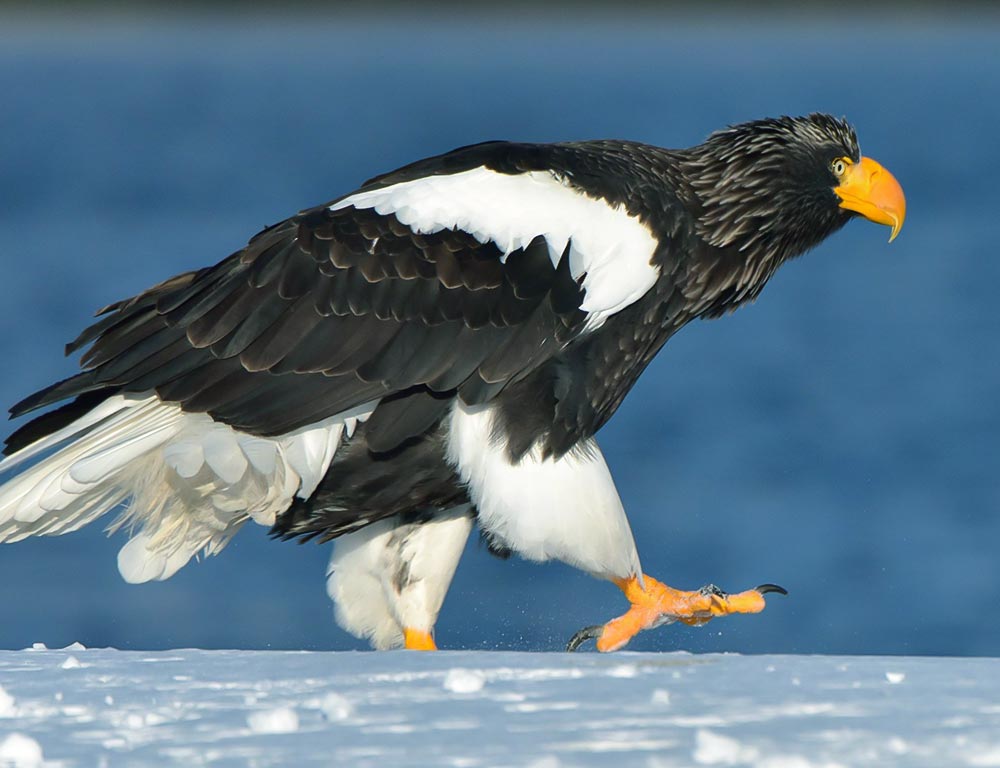
Bald eagles (Haliaeetus leucocephalus) are the most common species of eagles in Massachusetts. Here are some key characteristics and information about eagles in the state:
Appearance
Adult bald eagles have distinctive white heads and tails, with dark brown bodies and wings. Immature bald eagles have mottled brown and white plumage, and it takes about five years for them to develop the characteristic adult coloration.
Size
Bald eagles are large birds of prey, with a wingspan ranging from 6 to 7 feet. Adult males generally weigh between 8 to 9 pounds, while females are larger and can weigh up to 14 pounds.
Habitat
Eagles in Massachusetts are often found near large bodies of water, including lakes, rivers, and coastal areas. They require a combination of open water for hunting and mature trees for nesting.
Nesting
Eagles in Massachusetts typically build large nests in tall trees near water bodies. Nests can be reused over several years and may become massive structures as eagles add to them annually.
Diet
Bald eagles are opportunistic predators and scavengers. They primarily feed on fish but also consume birds, small mammals, and carrion.
Migration
Some eagles in Massachusetts may be migratory, while others are year-round residents. In winter, you may observe an increase in the number of eagles in the state as individuals from northern regions move south.
Conservation Status
Bald eagles were once endangered in Massachusetts due to habitat loss, pollution, and pesticide use (such as DDT).
Conservation efforts, including the banning of DDT, have contributed to the recovery of bald eagle populations, and they were removed from the federal endangered species list in 2007.
Monitoring and Protection
Conservation organizations and wildlife agencies in Massachusetts monitor eagle populations and habitats. Efforts are made to protect nesting sites and educate the public about the importance of preserving eagle habitats.
Observing bald eagles in Massachusetts can be a thrilling experience, and their recovery is a testament to successful conservation efforts.
If you’re interested in watching eagles, be sure to do so from a respectful distance to avoid disturbing these magnificent birds.
3 Types of Eagles in Massachusetts
Massachusetts has three magnificent eagle species: the Bald Eagle (Haliaeetus leucocephalus), the Steller’s Sea Eagle, and the Golden Eagle (Aquila chrysaetos). All these birds are formidable raptors, commanding attention with their impressive size and soaring flight.
1. Bald Eagle
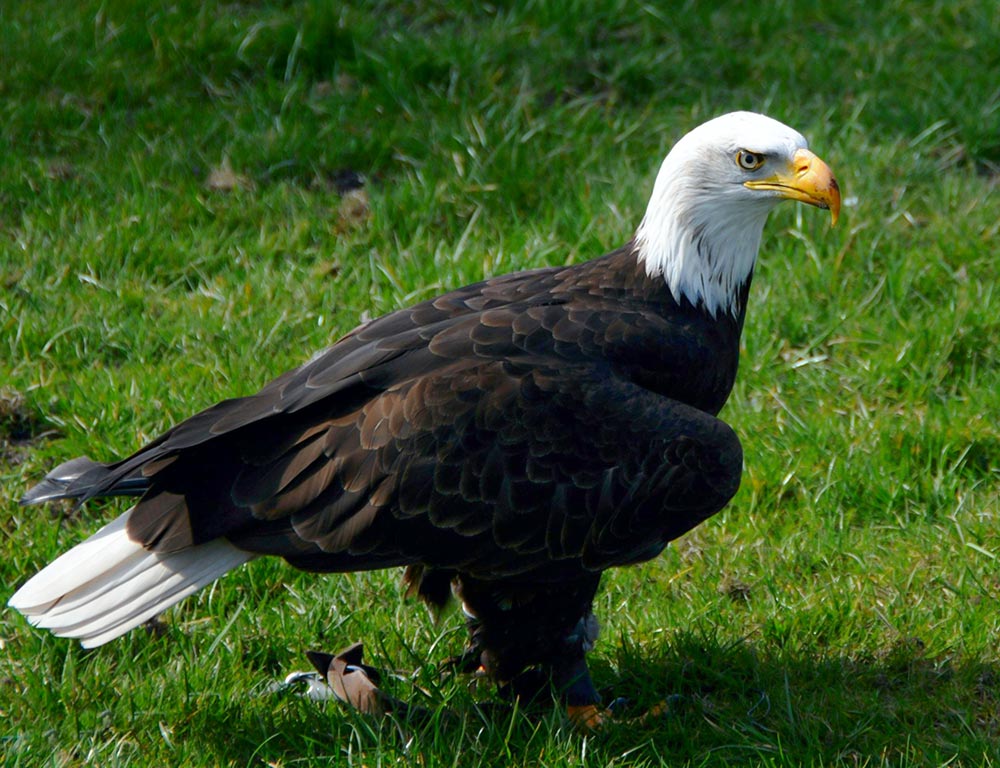
- Scientific Name: Haliaeetus leucocephalus
- Category: Bird of Prey
- Population: Recovering; stable populations in Massachusetts
- Life Span: Up to 20-30 years in the wild
- Size: 28-40 inches in length
- Weight: 8-14 pounds (males), 10-17 pounds (females)
- Food: Primarily fish, supplemented with birds, mammals, and carrion
- Wingspan: 6-7 feet
- Status: No longer listed as endangered; stable populations
The Bald Eagle symbolizes strength and freedom with its iconic white head and tail.
In Massachusetts, their populations have rebounded significantly since the days when they faced endangerment due to habitat loss and environmental pollutants like DDT. Bald Eagles are often spotted near water bodies, building massive nests in tall trees.
Their diet primarily consists of fish, but they are opportunistic predators, also preying on birds and mammals and scavenging carrion. With 6 to 7 feet wingspan, these majestic birds showcase their aerial prowess as they soar over lakes and rivers.
No longer listed as endangered, the Bald Eagle is a conservation success story, captivating observers with its impressive size and graceful flight.
2. Golden Eagle
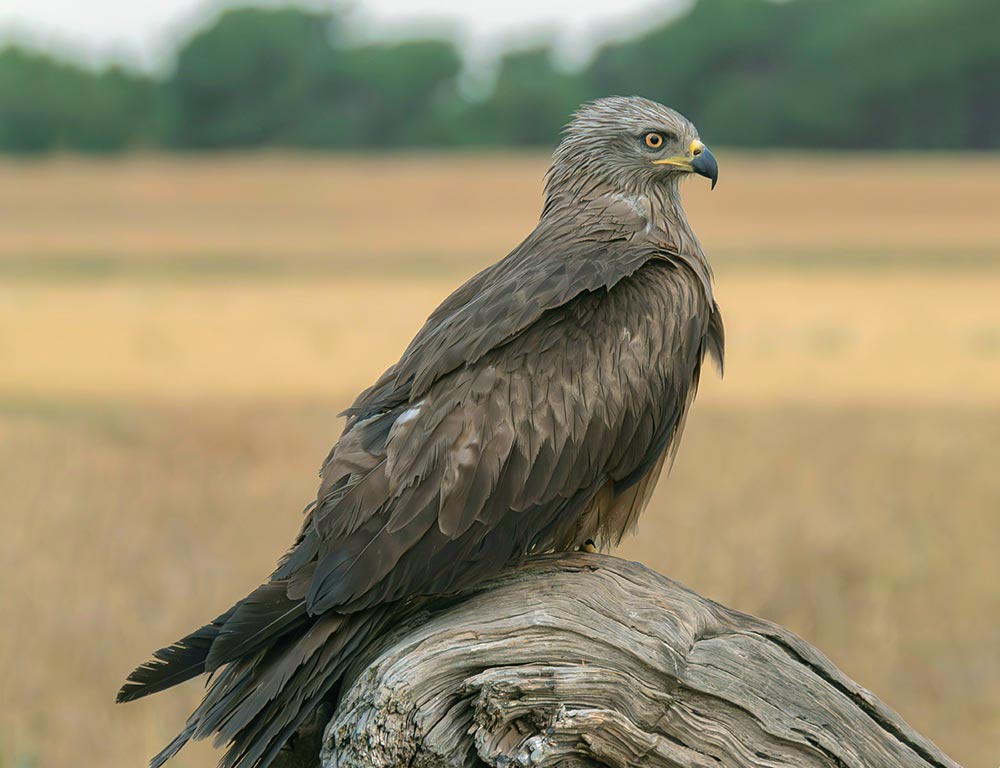
- Scientific Name: Aquila chrysaetos
- Category: Bird of Prey
- Population: Limited breeding pairs in Massachusetts
- Life Span: Up to 30 years in the wild
- Size: 26-40 inches in length
- Weight: 6-14 pounds (varies geographically)
- Food: Mainly mammals (hares, rabbits, ground squirrels), birds, and carrion
- Wingspan: 6-7.5 feet
- Status: Not listed as endangered, but some regional populations face threats
The Golden Eagle, a less common but equally awe-inspiring resident of Massachusetts, is recognized by its golden-brown plumage and powerful build.
Unlike the Bald Eagle, Golden Eagles are more versatile hunters, preying on mammals such as hares, rabbits, ground squirrels, birds, and carrion.
Their populations in Massachusetts are limited, with breeding pairs establishing territories in remote and rugged landscapes. Golden Eagles, with a wingspan of 6 to 7.5 feet, are known for their soaring flights and agile hunting techniques.
While not currently listed as endangered, some regional populations face threats, highlighting the importance of conservation efforts to ensure the continued presence of these majestic birds in the state’s diverse ecosystems.
3. Steller’s Sea Eagle

- Scientific Name: Haliaeetus pelagicus
- Category: Bird of prey, Accipitridae family
- Population: Relatively low, classified as vulnerable
- Life Span: Approximately 20 to 30 years in the wild
- Size: Length ranges from 85 to 105 cm
- Weight: Adults weigh between 5 to 9 kg
- Wingspan: Impressive wingspan of 1.95 to 2.5 meters
- Status: Classified as vulnerable due to habitat loss, pollution, and human disturbance
With its striking appearance, the Steller’s Sea Eagle showcases a dark brown plumage and a distinctive white head and tail.
This formidable bird of prey primarily inhabits coastal regions and is renowned for its exceptional fishing skills. Its robust build and powerful talons snatch fish from the water’s surface effortlessly.
The Steller’s Sea Eagle boasts a remarkable wingspan, allowing it to cover vast territories during its migratory patterns. Preferring a solitary lifestyle, these eagles are often observed perched on cliffs or trees near their hunting grounds.
Threats to their existence include habitat degradation, environmental contaminants, and human disturbance. Conservation efforts are crucial to safeguard this magnificent species and ensure the continued balance of their ecosystems.
Why Massachusetts Doesn’t Have Many Types of Eagle?
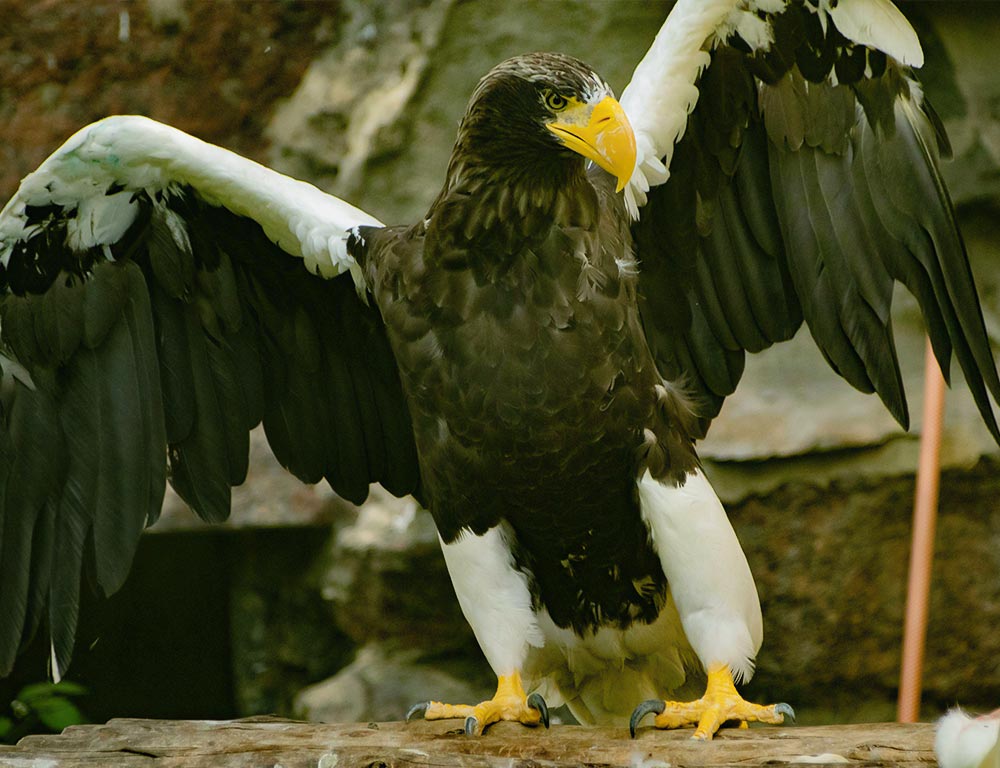
Massachusetts primarily hosts two types of eagles: the Bald Eagle (Haliaeetus leucocephalus) and the Golden Eagle (Aquila chrysaetos).
The limited diversity of eagle species in Massachusetts can be attributed to several ecological and historical factors:
Habitat Suitability
Massachusetts has diverse habitats, but the specific requirements of eagles limit the number of species.
Bald Eagles, for example, are often associated with large bodies of water for fishing, and Golden Eagles prefer more open landscapes for hunting mammals.
The availability of suitable habitats is crucial in determining which eagle species can thrive in an area.
Historical Decline
Historically, eagles, especially the Bald Eagle, faced significant population declines due to habitat destruction, pollution, and the use of pesticides like DDT. This decline may have limited the diversity of eagle species in the region.
Recovery Efforts
Conservation efforts, such as habitat protection and banning harmful pesticides, have contributed to the recovery of eagle populations in Massachusetts.
However, these efforts may have focused more on specific species, like the Bald Eagle, which was once listed as endangered. Recovery efforts for the Golden Eagles might not have been as extensive.
Geographical Location
Massachusetts is situated in the northeastern United States, and its climate and geography may be more suitable for certain eagle species. Golden Eagles, for instance, are more commonly found in western and mountainous regions.
Competition and Niche Specialization
Different eagle species may compete for similar resources; over time, one species may dominate a specific ecological niche.
The presence of dominant species like the Bald Eagle in Massachusetts might limit the establishment of additional eagle species.
Natural History and Evolutionary Factors
The evolutionary history of eagles may also play a role. Over time, certain species may have adapted better to the local environment and outcompeted or excluded other eagle species.
While Massachusetts may not host a wide variety of eagle species, the state’s efforts in conservation and habitat protection have successfully allowed the recovery of the Bald Eagle population.
Continued conservation measures are essential to ensure these majestic birds’ well-being and maintain the region’s ecological balance.
How to Increase the Variations of Eagles in Massachusetts?
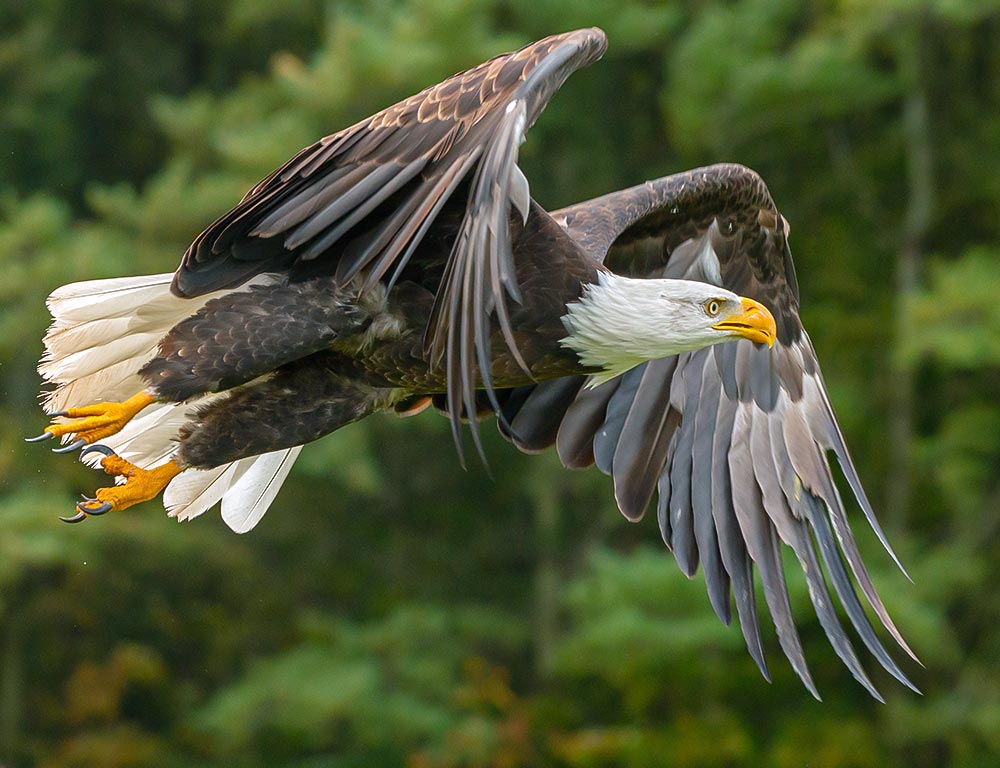
Increasing the variations of eagles in Massachusetts involves a combination of habitat conservation, active management, and public awareness efforts. Here are several strategies to enhance the diversity of eagle species in the state:
Habitat Preservation and Restoration
Identify and protect diverse habitats that could support a variety of eagle species. This includes both aquatic habitats for fishing eagles like the Bald Eagle and open landscapes for hunting eagles like the Golden Eagle.
Implement habitat restoration projects to enhance the quality and availability of suitable nesting sites and prey.
Research and Monitoring
Research the specific habitat requirements and ecological needs of different eagle species that could inhabit Massachusetts.
Establish comprehensive monitoring programs to track existing eagle populations and identify potential habitats for other species.
Conservation Partnerships
Collaborate with conservation organizations, wildlife agencies, and research institutions to implement effective conservation strategies.
Engage in regional and national partnerships to share knowledge and best practices for eagle conservation.
Mitigation of Threats
Identify and address potential threats to eagle populations, such as habitat loss, human disturbance, and potential hazards like lead poisoning or collisions with infrastructure.
Develop and implement mitigation measures to minimize threats to both existing and potential eagle species.
Public Awareness and Education
Increase public awareness about the importance of eagle conservation and the diversity of eagle species.
Engage in educational programs to inform communities about the significance of preserving diverse ecosystems and the role eagles play in maintaining ecological balance.
Legislation and Policy Support
Advocate for and enforce legislation that protects eagle habitats and supports conservation efforts. Work with policymakers to develop and implement policies that encourage habitat preservation and sustainable land management practices.
Community Engagement
Involve local communities in eagle conservation efforts, fostering a sense of stewardship and pride in these iconic birds. Encourage citizen science initiatives to involve residents in monitoring and reporting eagle sightings.
Research and Release Programs
Consider research and release programs for eagle species that may be struggling in the region. These programs can help reintroduce or reinforce populations.
Climate Change Adaptation
Factor in climate change considerations when planning conservation efforts to ensure that habitats remain suitable for various eagle species in the long term.
By implementing these strategies, Massachusetts can create a more favorable environment for various eagle species, contributing to the state’s overall biodiversity and ecological health.
Collaboration among government agencies, conservation organizations, and the public is essential for the success of these initiatives.
Wrapping Up
Fostering the diversity of eagle species in Massachusetts requires a holistic approach encompassing habitat preservation, proactive management, and community engagement.
By prioritizing conservation efforts, addressing potential threats, and raising public awareness, the state can create a thriving environment for various eagle species.
The success of these initiatives not only contributes to the ecological balance but also offers an opportunity for residents to witness and appreciate the majestic beauty of different eagles soaring across the diverse landscapes of Massachusetts.